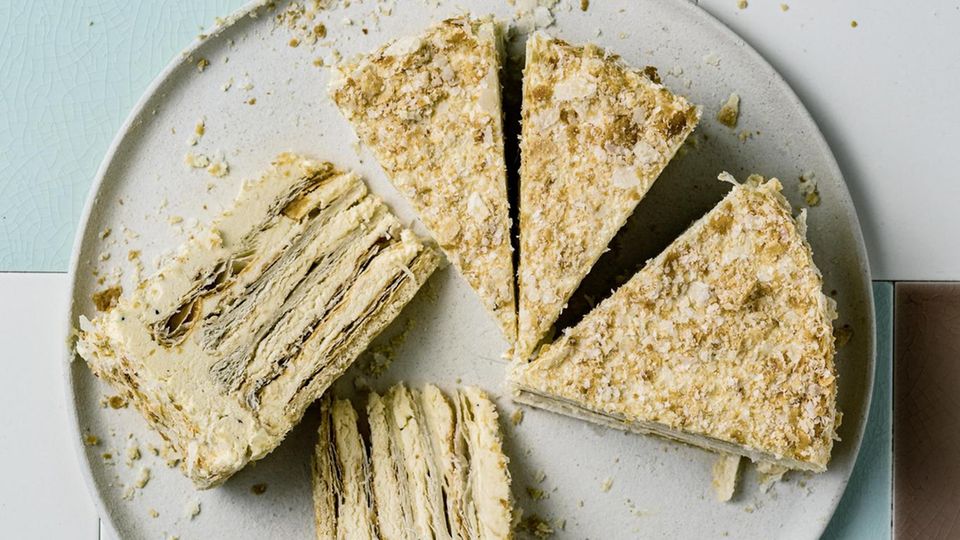Austria
Pastries with a fascist background? The dispute over the cardinal sections
The original cardinal slice is held together by apricot jam. There are now numerous variations, for example with coffee cream.
© bruhum / Imago Images
The Kardinalschnitte, a popular traditional pastry in Austria, is said to owe its name to a controversial figure. A newspaper article about it is currently making waves in the country.
It is no longer uncommon for dishes whose names are no longer contemporary to be renamed. No matter how far back the tradition may go, gypsy schnitzel and Mohrenkopf should be passé these days. The Austrian cardinal cuts are still a long way from this, but evil tongues are already suspecting that the current debate is heading in this direction.
On the occasion of his 90th birthday, “der Standard” questions the origins of the popular film Pastries – and brings up a controversial figure: the controversial Cardinal Theodor Innitzer.
Cardinal cuts were created for Catholic Day
The cut, named after the clergyman, consists of two layers of sponge cake and meringue strips held together by apricot jam. The colors yellow and white are not chosen randomly, but are intended – depending on the source – to represent the Holy See (according to the “Standard”) or the colors of the Vatican (according to the “Kurier”). In any case, they provide a clue to the occasion for which the pastry was invented.
In 1933, Catholic Day took place in Vienna from September 7th to 12th. At the time, Ludwig Heiner was commissioned by the KuK Hofzuckerbäckerei L. Heiner in Vienna to create a pastry, reports “the standard“. With its location between the archbishop’s palace and St. Stephen’s Cathedral, the pastry shop was the regular café of Cardinal Innitzer, who is said to have come and gone there.
Cardinal had a difficult relationship with the Nazi era
This is also why the pastries were named after the clergyman. However, according to the “courier” into the “darkest chapter of Austrian history.” At that time, a right-wing, authoritarian system of rule, known as Austrofascism, was established in Austria.

Birthplace of the cardinal cuts: The court confectioner in the Wollzeile in Vienna
© CHROMORANGE / Imago Images
Chancellor Engelbert Dollfuß should Catholic Day was used to propagate the Austrofascist corporate state. In his vision, the state – as “the Standard” writes – should be based on Christian principles. The bishops and the cardinal would have supported this.
Theodor Innitzer is also known for his unclear, ambivalent relationship to the Nazi era. In 1938 he and the bishops are said to have signed a declaration to the population to vote for “annexation” to Germany in the referendum. He should send an accompanying letter with “Heil Hitler!” have signed. Later he is said to have distanced himself from Nazi ideas by proclaiming Jesus Christ as the “only leader”. He is even said to have supported the relief office in the archbishop’s palace that helped Jews escape.
Konditorei sees the debate calmly
“It’s important to talk about this time,” says the current head of the Heiner confectionery, Verena Eissner-Eissenstein, to the portal “oe24“. One can still view the discussion calmly. Ludwig Heiner saw the Katholikentag as an opportunity to create a product. It is no longer possible to determine whether and what thoughts he had at the time. A bomb attack in the Second World War destroyed all possible records, so today’s boss.
Italian pastry chef
Sweet works of art – the miniature wonderland made of cakes
The Kardinalschnitte, on the other hand, has remained and is now one of the most popular desserts in the country; an integral part of every pastry menu. Presumably for this reason, the debate after the “Standard” article quickly made waves. However, the outrage that many people express in online forums is (still) unfounded. The name change of the pastry, which has already been announced in some media, is currently not up for debate.
Sources: “The standard“, “courier“, “oe24“


